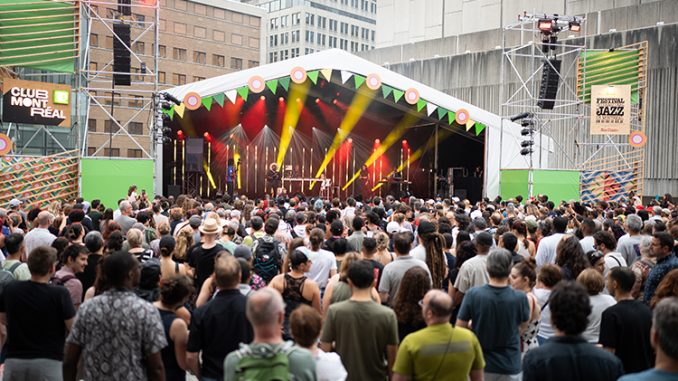
Montreal Jazz Festival, June 29 – July 8, Montreal, Canada
Review by Andy Hughes.
In common with all festivals, the Montreal Jazz Festival is recovering from the ravages of the Pandemic, and getting itself back to full strength.
This is the biggest festival of its kind in the world, now in its forty-third year, and it continues to push through the genre boundaries to prevent its massive diversity of live entertainment around the city.
Festival founders Alain Simard and Andre Menard saw an opportunity to utilise the vacant theatre and nightclub venues around the centre of Montreal during the summer. The Festival has grown from its original small-scale roots, into the present format, which sees a section of central Montreal closed to traffic for ten days, while an audience of around two million visitors enjoy a mix of legends from the world of jazz, mixed with the best contemporary and upcoming performers, together with a mix of wider musical genres including Afrobeat, Americana, and Blues.
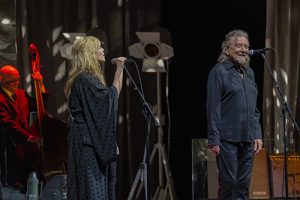
A massive six-hundred-and-fifty concerts run from midday until midnight, with two-thirds of the concerts providing free admission. Previous Festival bills have encompassed a range of diverse performers ranging from Bob Dylan to Tony Bennett, and from King Crimson to Noel Gallagher, not forgetting an incendiary set from Canada’s own thrash metal extremists Voivod.
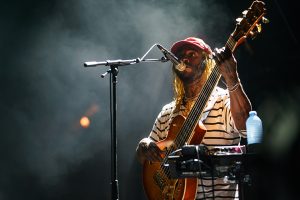
This year, shows ranged from the prodigiously exciting experience of Thundercat, whose outdoor show attracted around two-hundred-thousand neo-jazz fanatics, to the intimate atmosphere of Gesu, a converted church which hosted blues-mystic hybrid Harry Manx.
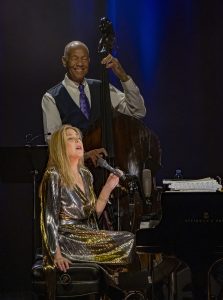
Add in the perfect acoustic venue of the Salle Wilfred-Pelletier, hosting the sublime piano jazz of Diana Krall on one night, the belting blues maestro Buddy Guy on another, and the perfect embodiment of modern Americana from Robert Plant and Alison Krauss, and the sheer diversity and range of the Festival becomes clear.
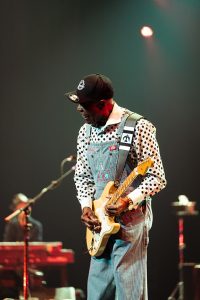
Montreal is an intriguing city. Virtually everyone you meet is bi-lingual – their particular brand of slang-ridden rapidly delivered French being the most common you will hear around you, while everyone effortlessly switches to English for the benefit of the massive influx of less adaptable tourists. The standard greeting in shops, hotels and restaurants is “Bonjour hi …” with the speaker continuing in the language offered by its recipient. Traffic is permitted right turns on red traffic lights, but drivers exhibit endless patience with road-crossing pedestrians, the sound of horns being reserved for the occasional dawdler or junction-crossing chancer motorists.
The weather is usually hot, although international weather patterns created some biblical thunderstorms and downpours, and the air was slightly polluted by the drift of smoke from out-of-control forest fires in the north of the country.
There is always a variety of Street Food stalls around the Festival site, serving hungry music fans with a wide variety of international cuisine. The most famous portable Quebec dish is Poutine, which consists of chips coated in a mixture of cheese curds and gravy. Non-French speakers, and those with questionable accents and pronunciation should be wary when attempting to ask for the famous snack, mispronunciation may lead the vendor to hear “Putain s’il vous plait …”, which means something entirely different, and can lead to a heated exchange, ending in an additional conversation with the Festival security staff!
Blues music has always been a strong feature of the Jazz Festival, with a specific stage being built in the outdoor performance area to cater for a range of Canadian and international blues musicians. Featured artists played two sets per evening, at nine and eleven o’clock, enabling visitors to plan their evenings not to miss a set by checking out other performances elsewhere on the site. The beauty of the Jazz Festival set-up is that almost all the major performance venues and outdoor stages are laid out within an area that can easily be traversed in around twenty minutes.
Particular highlights from the Blues contingent this year, came from the always reliable guitarist Steve Hill who has graced the festival more than twenty times in its history, together with performances from Dawn Tyler Watson and JW Jones whose individual performances saw the audience areas packed with enthusiastic blues fans.
Once again, the abiding memory of the Montreal Jazz Festival is the sheer diversity of the performers invited, and performances offered.
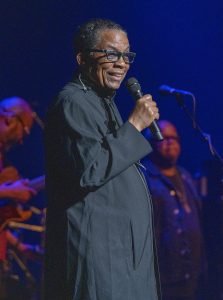
The sheer ‘out there’ magic of returning DOMi and JD Beck on the main outdoor TD Stage, the enduring popularity of the legendary Herbie Hancock, the Cuban funk of Cimafunk and the sonic mastery of progressive rock titans Snarky Puppy.
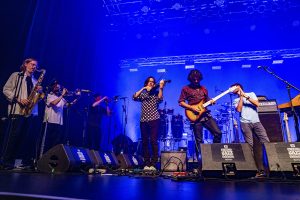
Not forgetting the anonymous but nonetheless important atmospheric additions, the Montreal street musicians who could be found on plenty of street corners, usually in ones and twos, and occasionally more developed combinations entertaining passing, and stopping Festival goers with a wide variety of musical styles and sounds.
The swathe of cessation of musical enjoyment created by the Covid outbreak has been felt deeply all around the world, causing immense artistic and economic damage to our beloved musical community. But as events such as the Byron Bay Bluesfest and the Big Red Bash here in Australia, have bounced back with commendable tenacity, as has Glastonbury over in England.
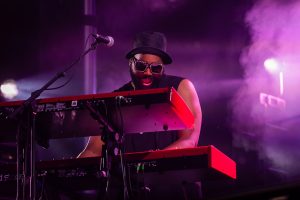
And Canada is no exception, with this year’s Montreal Jazz Festival proving that long-form Festivals are alive and well, and growing into their former glories at speed.
Music fans are advised to check out the initial performance information for the Montreal Jazz Festival in 2024, and ensure travel and accommodation plans are in place early, as flights and hotels fill up very quickly. A visit to the beautiful city of Montreal, and its ever-adventurous musically diverse Jazz Festival, is a travel and artistic experience that belongs on everyone’s ‘to do’ list for next summer. See you there!

